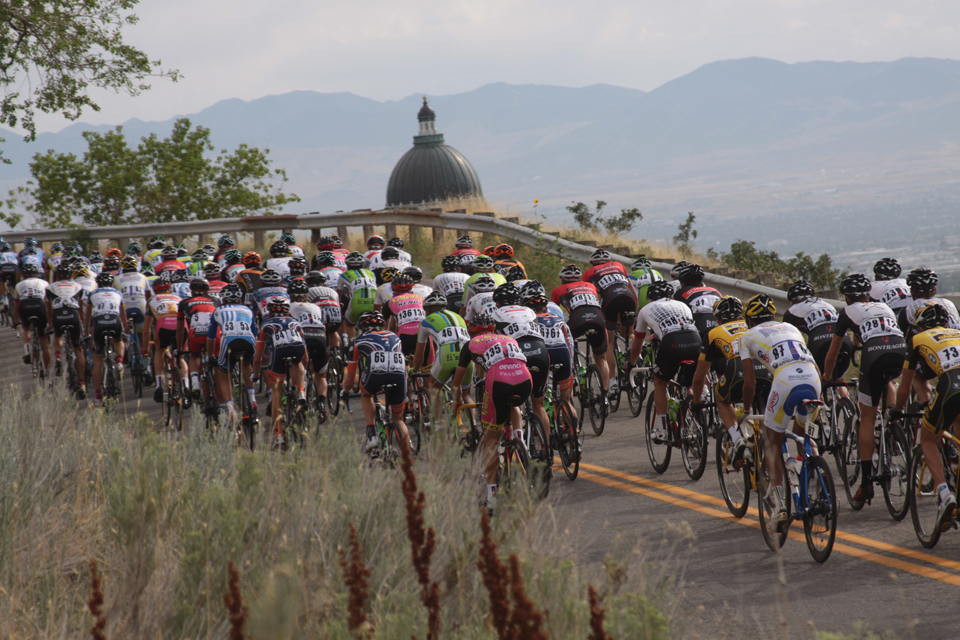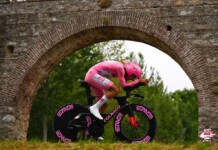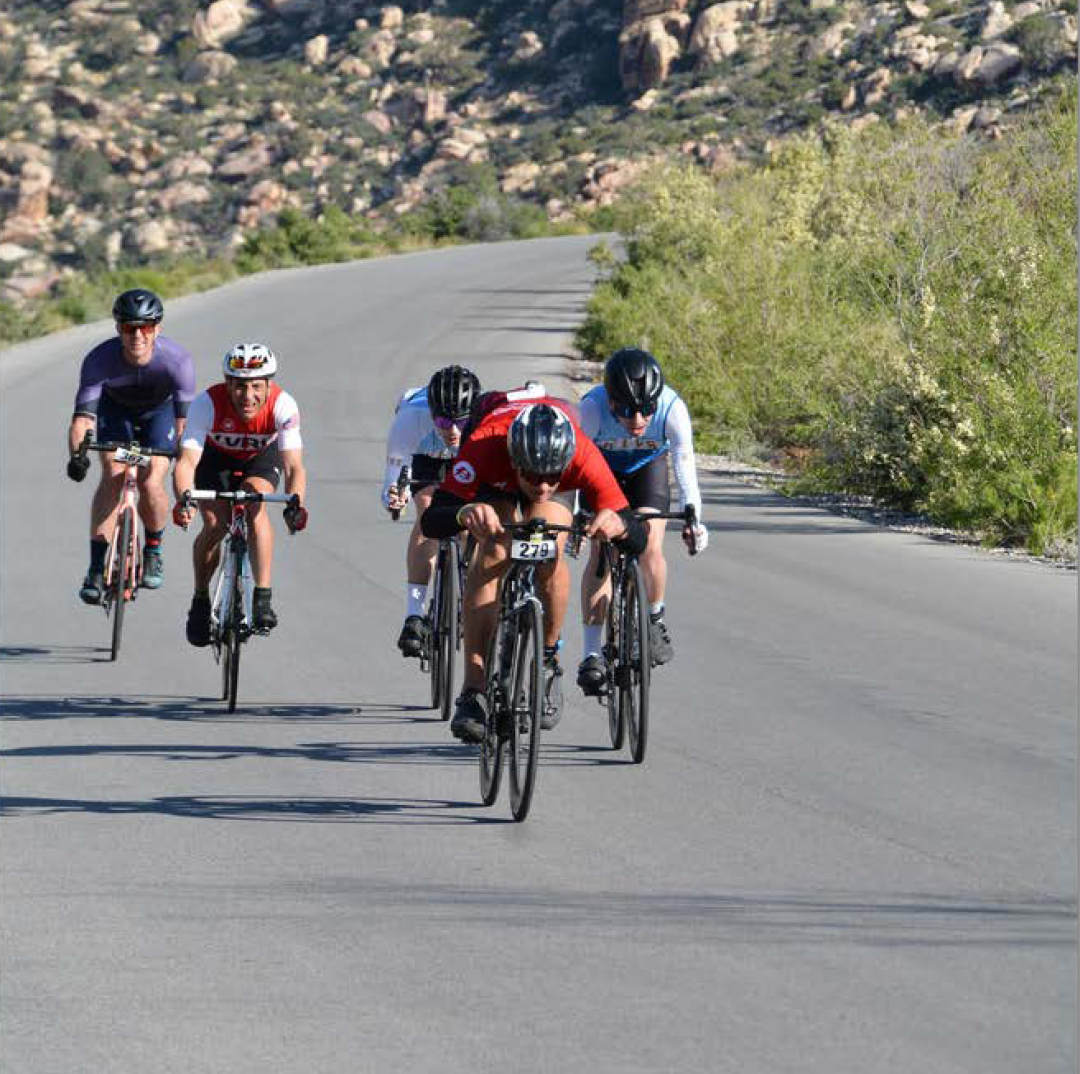A Guide to Bike Racing Terms
Compiled by Greg Overton

Attack v. to accelerate from the front of a pack or peloton in order to create distance between yourself and the rest of the field.
n. reference to an effort put forth. ‘The two-man attack stayed off the front until the finish.”
Bacon n. scabs that form on a rider’s body as road rash heals. “Dude, crispy bacon. You’re healing nicely, I see.’
Blocking v. to move to the front of the pack and slow down in order to help a teammate who has attacked, usually done by several teammates of the attacking rider(s). Note: intentional weaving or other dangerous methods of blocking rivals is punishable by being ridden into the ditch followed by name-calling.
Brakes unknown, but we think that’s how it’s spelled.
Breakaway n. successful attack that maintains its lead on the peloton to the finish. A strong breakaway that is caught by the pack just before the finish is called a good effort, but exhausts you and leaves you weary, as opposed to a winning breakaway, which makes you feel great!
Bridge v. rider or group of riders attempting to accelerate away from one group in order to catch up with another group riding ahead.
Broom Wagon n. support vehicle in a race that follows the last rider or group of riders on the course; vehicle that sweeps-up abandoned riders.
Cashed adj. bonked, hammered; knackered, battered, rolled under, screwed, tired, fatigued. ‘Dude, I’m cashed, where’s the feed zone and the broom wagon?” Chamois n. padding in shorts that hopefully prevents saddle sores, originally made from goatskin. Now made from various high tech moisture wicking man-made materials, thank goodness.
Chase n. pretty much everyone behind the leader is in the chase, but it usually refers to those working the hardest to catch riders who are up the road. v. to ride like crazy trying to catch up with a rider ahead of you. Can be used together in the same sentence, usually in response to your team director, “I chased as hard as I could, but no one else in the chase would do squat.”
Commissaire n, referee of the race. A race may have several of these in order to ensure that all competitors comply with the rules of the sport. The head commissaire is usually found standing through the open sunroof of a race vehicle, yelling or pointing. Or both.
Crayon v, “art” of painting the road with one’s skin, clothing, tires etc. during a crash. If you crayon with your skin, you’ll surely form bacon in a few days.
Dance on the Pedals v. refers to the way great climbers seem to be weightless as they bounce up the hills on their bikes. Also referred to as ‘running up a hill with a bike underneath you.”
Death March n. ride or race that causes you to explore the dark corners of your constitution, a long ride that finds you cashed with many miles still to ride. Also called a Three Hour Tour (ref Gilligan’s Island) or the Deer Valley to Sundance stage of the Tour of Utah.
Directeur Sportif n. race team manager, the Boss. Not to be confused with the sponsors – who are the Real Boss.
Domestique n. servant. A team member who must sacrifice his own ambition to help the designated team leader in a particular race by riding tempo, blocking, offering his water bottle, a wheel and sometimes his whole bike if it prevents the leader losing time.
Draft v. to ride in the protected slipstream of a rider directly in front. Or behind a team car if the commissaire is not around.
Dropped v. result of failure to maintain the speed of the riders in your pack. The faster riders drop the slower riders. Also known as being “off the back”.
Echelon n. a paceline that’s gone a bit wonky as a result of a crosswind. Instead of a single file line following the direction of the road, the echelon is a diagonal line across the road wherein riders shield themselves from a crosswind beside the next rider.
Engine n. the rider. Some riders are big engines; others are bigger ones.
Feed Zone n. area designated along the racecourse where it is acceptable for support crews to hand food and drinks to riders as they pass by. Sometimes the feed zone is relegated as neutral and no riders may attack there, but even if not officially deemed so, cycling etiquette maintains that no one attack near the feed zone. Don’t do it, it’s bad juju.
Forcing the Pace v. to ride at the front of the pack at a high speed so that other riders cannot launch an attack. Usually done by the strongest team to control the race. Also known as the act of “riding tempo’.
Fred n. person who spends a lot of money on equipment, but still can’t ride. Too much ‘show” and not enough “go”. Also called a Wanker, Barney or Waif (as in supermodel).
General Classification n. overall standings of a stage race based upon the accumulated times of the riders after each stage. Rider with lowest total time leads. For street cred, just say “GC”.
Hanging On v. last thing a cashed rider does before being dropped. Also called hanging in or dangling.
Hook v. act of placing your elbow in front of the shoulder or arm of the rider next to you during a sprint. It gives you an edge and it really dulls his.
Involuntary Dismount n. to crash, to chunder, to eat it, to have a yard sale.
Kermesse n. race that usually takes place on a course of three to ten kilometers with riders racing several laps. In the States, we call it a circuit race.
Lantern Rouge n. red light on a train’s caboose, or the last placed rider in a stage race.
Laughing Group n. group of slow riders left behind on a climbing stage. Earned its name by the riders telling jokes and funny stories while riding to the finish at a comfortable pace. Known as the autobus in France and the grupetto in Italy.
Moto n. race official who rides a motorcycle in order to keep an eye out for rider safety and infractions along the road during the race. Also relays information and time splits to the riders.
Musette n. shoulder bag containing food and drink handed up to riders in the feed zone.
On the Rivet n. at full speed. Originated from the days when saddles were leather skins attached to steel rails by large rivets front and rear. To be ‘on the rivet’ meant that a rider was on the nose of the saddle, on the rivet, and going like stink.
Paceline n. single file line of riders, each taking turns ‘pulling” at the front at a fast pace, then peeling off to float back to the rear of the paceline. The paceline allows a group to share the workload of riding into the wind, so that the others can draft and recover before pulling again.
Palmares n. list of results and awards won during a racer’s career. The great Eddy Merckx owns the most impressive palmares, with 525 race wins, approximately 33% of races entered. The great Lance Armstrong has 35.
Peloton n. a pack or group containing the largest number of riders along the racecourse.
Prang v. to bend, dent, gouge, scrape or otherwise damage bike or body during an involuntary dismount.
Prime (say preem) n. mid-race sprint for prizes, points, or time bonuses.
Rolling Closure n. type of traffic control used in most stage races wherein a group of escort vehicles form a caravan in front of and behind the race along the road to ensure safety for the racers while affecting automobile traffic as little as possible.
Rookie Mark n. grease mark in the shape of a chain ring appearing on the rear of a rider’s leg. Arrive for several group rides with this mark and earn your Fred status. Sometimes called ‘Cat 5 mark”.
Schwag n. free stuff handed out by manufacturers and sponsors at bike shows, races and events. The amount of schwag one gathers is usually inverse to the amount of shame one has.
Sitting in v. failure to take your pull in a paceline. Sometimes necessary because a rider is cashed and cannot generate the energy to pull at the front of the group, and sometimes a parasitic method of saving energy to launch an attack or sprint for the finish line. Racing etiquette strongly discourages the latter.
Snap adj. fast twitch muscular speed used to accelerate quickly. ‘Dude, I’m knackered, I have no snap.” Information usually followed by an attack from rivals.
Spin adi. type of pedaling style employing a smooth, high cadence in lower gears. It’s not easy, but the ability to spin effectively will conserve energy while creating speed. Ref: Lance Armstrong, who taught Alberto Contador a little too well.
Stage Race n. multi day race incorporating several types of races into a group contested by a large peloton of riders. The rider who finishes with the lowest accumulated time after completion of all of the stages is victorious. Also known as the Tour of Utah, among others in France and Italy.
Time Trial n. type of race in which individuals or teams race the same course separately, while being timed. Usually held on out-and-back or loop courses, riders leave at specified intervals, with the fastest time winning. Also known as The Race of Truth.
Tubular n. type of lightweight tire with the tube enclosed in the tire casing, which is stitched along the inside. Preferred by most racers for their light weight and low rolling resistance, tubulars are glued to the rims with high strength cement specifically made for the job. Also called “sewups’.







